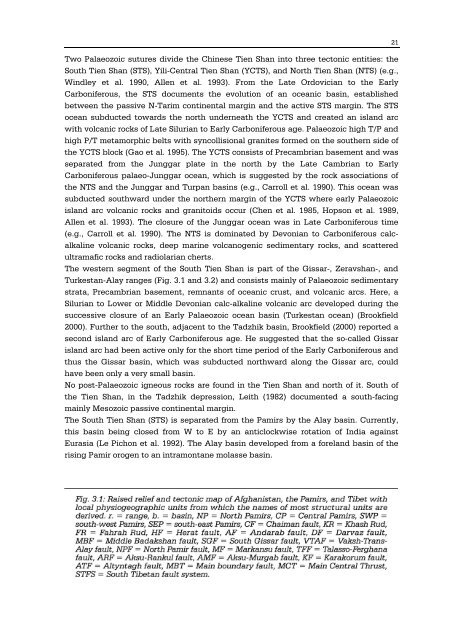tübinger geowissenschaftliche arbeiten (tga) - TOBIAS-lib ...
tübinger geowissenschaftliche arbeiten (tga) - TOBIAS-lib ...
tübinger geowissenschaftliche arbeiten (tga) - TOBIAS-lib ...
Create successful ePaper yourself
Turn your PDF publications into a flip-book with our unique Google optimized e-Paper software.
Two Palaeozoic sutures divide the Chinese Tien Shan into three tectonic entities: the<br />
South Tien Shan (STS), Yili-Central Tien Shan (YCTS), and North Tien Shan (NTS) (e.g.,<br />
Windley et al. 1990, Allen et al. 1993). From the Late Ordovician to the Early<br />
Carboniferous, the STS documents the evolution of an oceanic basin, established<br />
between the passive N-Tarim continental margin and the active STS margin. The STS<br />
ocean subducted towards the north underneath the YCTS and created an island arc<br />
with volcanic rocks of Late Silurian to Early Carboniferous age. Palaeozoic high T/P and<br />
high P/T metamorphic belts with syncollisional granites formed on the southern side of<br />
the YCTS block (Gao et al. 1995). The YCTS consists of Precambrian basement and was<br />
separated from the Junggar plate in the north by the Late Cambrian to Early<br />
Carboniferous palaeo-Junggar ocean, which is suggested by the rock associations of<br />
the NTS and the Junggar and Turpan basins (e.g., Carroll et al. 1990). This ocean was<br />
subducted southward under the northern margin of the YCTS where early Palaeozoic<br />
island arc volcanic rocks and granitoids occur (Chen et al. 1985, Hopson et al. 1989,<br />
Allen et al. 1993). The closure of the Junggar ocean was in Late Carboniferous time<br />
(e.g., Carroll et al. 1990). The NTS is dominated by Devonian to Carboniferous calcalkaline<br />
volcanic rocks, deep marine volcanogenic sedimentary rocks, and scattered<br />
ultramafic rocks and radiolarian cherts.<br />
The western segment of the South Tien Shan is part of the Gissar-, Zeravshan-, and<br />
Turkestan-Alay ranges (Fig. 3.1 and 3.2) and consists mainly of Palaeozoic sedimentary<br />
strata, Precambrian basement, remnants of oceanic crust, and volcanic arcs. Here, a<br />
Silurian to Lower or Middle Devonian calc-alkaline volcanic arc developed during the<br />
successive closure of an Early Palaeozoic ocean basin (Turkestan ocean) (Brookfield<br />
2000). Further to the south, adjacent to the Tadzhik basin, Brookfield (2000) reported a<br />
second island arc of Early Carboniferous age. He suggested that the so-called Gissar<br />
island arc had been active only for the short time period of the Early Carboniferous and<br />
thus the Gissar basin, which was subducted northward along the Gissar arc, could<br />
have been only a very small basin.<br />
No post-Palaeozoic igneous rocks are found in the Tien Shan and north of it. South of<br />
the Tien Shan, in the Tadzhik depression, Leith (1982) documented a south-facing<br />
mainly Mesozoic passive continental margin.<br />
The South Tien Shan (STS) is separated from the Pamirs by the Alay basin. Currently,<br />
this basin being closed from W to E by an anticlockwise rotation of India against<br />
Eurasia (Le Pichon et al. 1992). The Alay basin developed from a foreland basin of the<br />
rising Pamir orogen to an intramontane molasse basin.<br />
21

















